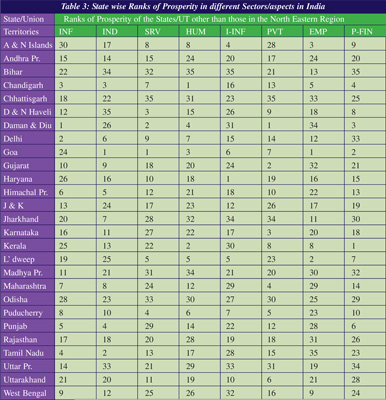Archives
STATUS OF DEVELOPMENT OF NE STATES OF INDIA IN THE NATIONAL PERSPECTIVE
 During the entire British colonial period in India, North East India was ruled as a part of the Bengal Province. Assam attained her statehood in 1874. After India won freedom, the Northeastern region of British India consisted of Assam and the Princely States of Manipur and Tripura. The territory under Nagaland came under the governance of Nagaland Transitional Provisions Regulation in 1961 and later attained its statehood in 1962. Under the North Eastern Region (reorganization) Act, 1971, Tripura, Manipur and Meghalaya became full - fledged States in 1972. Manipur was a union territory from 1962 until it became a full - fledged State in 1972. Tripura was a Union Territory since 1956 until 1972. The State of Meghalaya was carved out of Assam. The Union Territory of Mizoram came into being in 1972 and she attained her statehood in 1987. The territory under Sikkim was under the suzerainty of India, which controlled its external affairs, defense, diplomacy and communications, but Sikkim otherwise retained administrative autonomy. Sikkim became a State in 1975. The North East Frontier Agency (NEFA) was created in 1955. NEFA was renamed in 1972 and became the Union Territory of Arunachal Pradesh, which became the State of Arunachal Pradesh in 1987.
During the entire British colonial period in India, North East India was ruled as a part of the Bengal Province. Assam attained her statehood in 1874. After India won freedom, the Northeastern region of British India consisted of Assam and the Princely States of Manipur and Tripura. The territory under Nagaland came under the governance of Nagaland Transitional Provisions Regulation in 1961 and later attained its statehood in 1962. Under the North Eastern Region (reorganization) Act, 1971, Tripura, Manipur and Meghalaya became full - fledged States in 1972. Manipur was a union territory from 1962 until it became a full - fledged State in 1972. Tripura was a Union Territory since 1956 until 1972. The State of Meghalaya was carved out of Assam. The Union Territory of Mizoram came into being in 1972 and she attained her statehood in 1987. The territory under Sikkim was under the suzerainty of India, which controlled its external affairs, defense, diplomacy and communications, but Sikkim otherwise retained administrative autonomy. Sikkim became a State in 1975. The North East Frontier Agency (NEFA) was created in 1955. NEFA was renamed in 1972 and became the Union Territory of Arunachal Pradesh, which became the State of Arunachal Pradesh in 1987.
Specialties of the North Eastern Region:
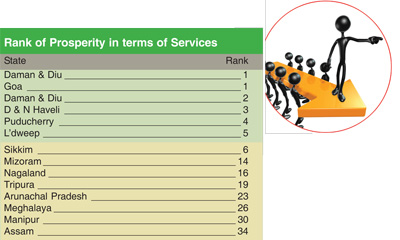 Topographically, except for the Brahmaputra, Barak (in Assam) and Imphal (in Manipur) valleys and some flatlands in between the hills of Meghalaya and Tripura that together account for about one - third of its total area, the remaining two - thirds of the area in the region is hilly terrain interspersed with valleys and plains. Most of the States in the region have about two - third of their geographical area under forests. The economy in the region is primarily agrarian, although little land, mostly in the plains, is available for settled cultivation. The practice of Jhum (shifting) cultivation is prevalent in many parts of the region. As a result, the agricultural productivity is low. Although the region is endowed with a considerably rich reserve of natural resources, topographical features, inaccessibility, socio-economic climate, etc. inhibit rapid industrialization. It may be noted that the region has a number of constraints in its connectivity to the rest of the nation. The Siliguri Corridor (West Bengal), with a narrow pass, connects the region with the mainland of the country. The region shares about 4500 km. of international border (approximately 90 per cent of its entire border area) with China, Myanmar, Bangladesh and Bhutan, with its special prospects and constraints. The region has over 150 Scheduled Tribes and some 400 other ethnic groups, most of them struggling with the problems of identity and self - preservation as well as special claims to attention and privileges. Development is often associated with connectedness, deterritorialisation and integration facilitating easy flow of resources as well as people. Unfortunately, the specialties of the region provide only a modest scope for them, mainly due to its disadvantageous geographical location. The region requires, therefore, political integration with the rest of the country and economic integration with the rest of Asia on its borders.
Topographically, except for the Brahmaputra, Barak (in Assam) and Imphal (in Manipur) valleys and some flatlands in between the hills of Meghalaya and Tripura that together account for about one - third of its total area, the remaining two - thirds of the area in the region is hilly terrain interspersed with valleys and plains. Most of the States in the region have about two - third of their geographical area under forests. The economy in the region is primarily agrarian, although little land, mostly in the plains, is available for settled cultivation. The practice of Jhum (shifting) cultivation is prevalent in many parts of the region. As a result, the agricultural productivity is low. Although the region is endowed with a considerably rich reserve of natural resources, topographical features, inaccessibility, socio-economic climate, etc. inhibit rapid industrialization. It may be noted that the region has a number of constraints in its connectivity to the rest of the nation. The Siliguri Corridor (West Bengal), with a narrow pass, connects the region with the mainland of the country. The region shares about 4500 km. of international border (approximately 90 per cent of its entire border area) with China, Myanmar, Bangladesh and Bhutan, with its special prospects and constraints. The region has over 150 Scheduled Tribes and some 400 other ethnic groups, most of them struggling with the problems of identity and self - preservation as well as special claims to attention and privileges. Development is often associated with connectedness, deterritorialisation and integration facilitating easy flow of resources as well as people. Unfortunately, the specialties of the region provide only a modest scope for them, mainly due to its disadvantageous geographical location. The region requires, therefore, political integration with the rest of the country and economic integration with the rest of Asia on its borders.
Objectives and the Basis of the Discourse:
| The region has over 150 Scheduled Tribes and some 400 other ethnic groups, most of them struggling with the problems of identity and self - preservation as well as special claims to attention and privileges. |
This exposition intends to bring out the position of the North Eastern States vis-à-vis the other States of India in matters of prosperity or development. This attempt at positioning has been done on the basis of the most recent data that is available as well as comparable. The data has been compiled from different secondary sources publically available and pertain mostly to the year 2007-08. Thus, an attempt has been made to present a quantitative picture of relative prosperity of the States in the North Eastern region in comparison to the other States in the country.
Like many other words representing complex concepts, development or prosperity also is a tag that encapsulates and represents a multidimensional connotation that an economic or spatial entity such as a country, State or district possesses and which may be described by an indefinite array of properties or characteristics often times expressible in cardinal or ordinal numbers. When we say that a State A is more developed vis-à-vis State B, we usually mean that the former is more evolved, happy, powerful, resourceful, wealthy, etc. than the latter. To capture this multidimensionality of development, this study visualizes eight aspects of development, namely:
- Availability of physical infrastructure related to transport, communication and power,
- Industrial performance,
- Social or institutional infrastructure relating to health and education,
- Service sector relating to financial institutions and openness of the region as measured by performance of tourism sector,
- Human development relating to some demographic features, health, education and purchasing power,
- Employment of the human resources,
- Privatization of industry and investment and
- Public efforts expressed in terms of govt. expenditure to facilitate promotion, maintenance and governance of development activities.
All these aspects of development may be represented by a set of quantitative measures and thus each of these aspects of development is multidimensional in nature. The list of various indicators for quantification of development aspects has been presented in table - 1.
 |
|
|
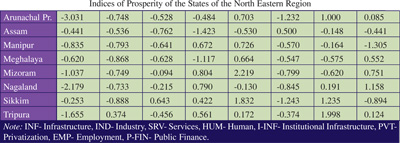 |
|
|
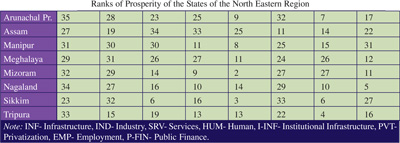 |
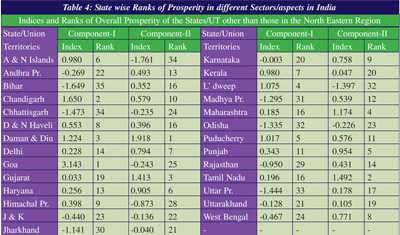 |
 |
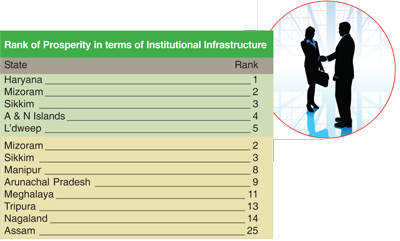
This effort on quantification of different aspects of prosperity does not assert that every aspect thereof can or should be quantified, nor does it assert that there are no aspects of development that warrant only qualitative or descriptive exposition. We fully agree with Adelman and Morris (1965, p.578) who asserted: “[T]he purely economic performance of a community is strongly conditioned by the social and political setting in which economic activity takes place. … [T]he splitting off of homo economicus into a separate analytic entity … is much less suited to countries which have not yet made the transition to self-sustained economic growth.” The historical forces – the sequence of events that took place in political integration of the North Eastern States in the Indian nation and the manner in which the inhabitants of the North Eastern States have welcomed them bear vitally on the performance of development of these States and those influences can only be described and not quantified. It also may take note of the fact that quantification of development, especially in less developed regions, has its own limitations since development and availability as well as reliability of quantitative indicators of development reciprocate each other. As Kuznets (1957, p. 548) has observed: “There is little question that, unless critically analyzed, much of the apparently quantitative record for the early periods of developed economies and even the current statistics for underdeveloped countries is almost worthless.” Imposing too much structure (sophisticated statistical analysis presumes a number of conditions that the data must satisfy for the analysis to be applicable and yielding meaningful results) on deficient data may be unavailing (Fogel, 2001). Thus quantitative analysis of data without caution may be ineffective or misleading.
Methodology:
| The historical forces – the sequence of events that took place in political integration of the North Eastern States in the Indian nation and the manner in which the inhabitants of the North Eastern States have welcomed them bear vitally on the performance of development of these States |
It has already been mentioned that this study visualizes eight aspects of development that are multidimensional. However, it is well recognized that, like in case of all other objects that have multidimensional connotation, it is not always possible to establish an order relationship among different instances of the object on the basis of the criterion of development or prosperity. Therefore, for the sake of comprehension as well as practical purposes, it is often required that the multidimensional point is made to collapse into a single dimensional point, the latter being an image of the former. Such an exercise is necessarily an endeavor to represent the array of points by some sort of averages derived from them.
| In matters of physical infrastructure (INF) all the North Eastern States are placed at a below - median position, which is corresponded by their ranks in matters of industrialization (IND). |
There is no single, unanimously acceptable and ‘the best’ method to represent the array of multidimensional points by their corresponding single dimensional points. The alternative methods, therefore, range between working out un-weighted (arithmetic or geometric) averages to weighed measures of central tendency in which weights are chosen subjectively / arbitrarily, determined by extraneous considerations or derived intrinsically so as to satisfy certain given criteria. The prevalent measures of human development apply the technique of un - weighted averages, whether arithmetic or geometric. The methods of principal component analysis (without rotation) and factor analysis (with varied schemes of extraction and rotation) are the methods of the last sort that derive weights intrinsically so as to satisfy certain given criteria.
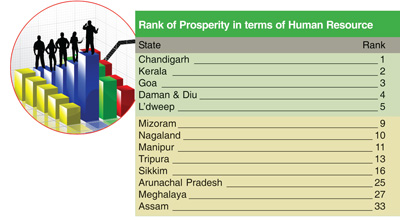
| Although the region is endowed with a considerably rich reserve of natural resources, topographical features, inaccessibility, socio-economic climate, etc. inhibit rapid industrialization. |
Let us denote the array of single dimensional points (each point being a measure of the level of prosperity of an economic, geographical or political object such as a country or State) by which is an image (more often a linear combination) of the m - dimensional points, X such that Zi=?mj=1 xijwj where is the weight assigned to the jth characteristics of the ith instance. If the weights are determined such that the sum of squared correlation between Z and Xj EX or, alternatively stated, ?mj=1 r2(Z,xj) is maximized, we obtain as the principal component based array of single dimensional points, called an index. Such Z attains the global maximum. Moreover, if there is another linear combination Y =?mj=1xjvj; v ? w that attains a local maximum, then and Y is orthogonal or the coefficient of correlation between and is zero. The method of principal component for constructing an index, derived from (an array of multidimensional points measuring some particular aspects of prosperity) is attributed to Hotelling (1933). Kuznets (1949) paved the way and provided a conceptual framework to represent and measure prosperity of economic-cum-spatio-political units by an array of variables measuring various aspects of prosperity (Syrquin, 2005). Adelman and Morris (1965, 1967) first applied factor analysis for measuring levels of development (Fagerberg & Srholec, 2007).
Empirical Findings:
The scores obtained by different States for various aspects of prosperity (development) have been presented in table - 2 and accordingly the ranks obtained by different States regarding various aspects of prosperity have been presented in table - 3.
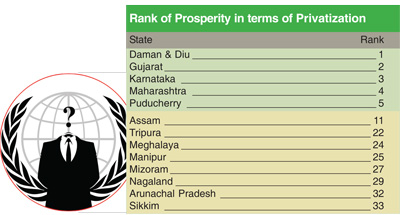 From table - 3 it may be leant that in matters of physical infrastructure (INF) all the North Eastern States are placed at a below - median position, which is corresponded by their ranks in matters of industrialization (IND). Tripura is only an exception that it has occupied an above-median rank of 15, even with a poor state of infrastructure. In matters of privatization Assam is an exception (ranks 11), while all other States in the NER obtain below - median ranks. In other aspects we have a rather mixed scenario. In financial services, banking, and exposure to the State to visitors (SRV) Mizoram, Nagaland and Sikkim win above - median ranks while Arunachal Pradesh, Assam, Manipur, Meghalaya and Tripura obtain below - median ranks. In matters of employment (EMP) Meghalaya and Mizoram are below - median States while other six States in the NER are placed in the above - median positions. In terms of human development (HUM) Arunachal Pradesh, Assam and Meghalaya rank below - median. In matters of public efforts to facilitate and maintain developmental activities (P - FIN) Assam, Manipur and Sikkim are placed at below - median positions. Incongruence among the different aspects of development shows rigidities, gaps, imbalances in priorities and the efforts made to promote different aspects in coordination with each other. It may also emerge on account of the physical differences that the States in the NER have with each other.
From table - 3 it may be leant that in matters of physical infrastructure (INF) all the North Eastern States are placed at a below - median position, which is corresponded by their ranks in matters of industrialization (IND). Tripura is only an exception that it has occupied an above-median rank of 15, even with a poor state of infrastructure. In matters of privatization Assam is an exception (ranks 11), while all other States in the NER obtain below - median ranks. In other aspects we have a rather mixed scenario. In financial services, banking, and exposure to the State to visitors (SRV) Mizoram, Nagaland and Sikkim win above - median ranks while Arunachal Pradesh, Assam, Manipur, Meghalaya and Tripura obtain below - median ranks. In matters of employment (EMP) Meghalaya and Mizoram are below - median States while other six States in the NER are placed in the above - median positions. In terms of human development (HUM) Arunachal Pradesh, Assam and Meghalaya rank below - median. In matters of public efforts to facilitate and maintain developmental activities (P - FIN) Assam, Manipur and Sikkim are placed at below - median positions. Incongruence among the different aspects of development shows rigidities, gaps, imbalances in priorities and the efforts made to promote different aspects in coordination with each other. It may also emerge on account of the physical differences that the States in the NER have with each other.
The overall Level of Prosperity:
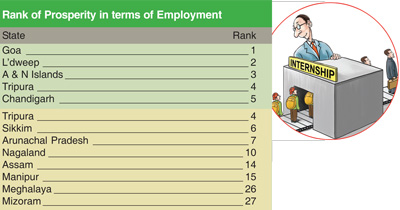 For obtaining the overall indices of prosperity, the sectoral or aspect - wise indices have been subjected to the principal component analysis. In this analysis two components have clearly emerged. The scores related to the 1st principal component are closely correlated with human development (HUM), services (SRV) and public finance (P-Fin) while the 2nd principal component scores are closely correlated with infrastructure (physical and institutional) and privatization. These indices and the ranks obtained by different States are presented in table-4. According to the scores of component - I, two groups of States in the NER emerge. Arunachal Pradesh, Assam, Manipur and Meghalaya fall in the first group that obtained below - median ranks. The other four States are in the second group that lies above the median. According to the scores of component - II, none of the States obtain above - median rank. This clearly shows that in matters of infrastructure and privatization (that is closely correlated with industrialization and globalization) the NE States clearly lag behind. However, in matters of human development and services some NE States (Mizoram, Nagaland, Tripura and Sikkim) are better off. Such indications have been given in other research works (Government of Tripura, 2007; Nayak, 2010).
For obtaining the overall indices of prosperity, the sectoral or aspect - wise indices have been subjected to the principal component analysis. In this analysis two components have clearly emerged. The scores related to the 1st principal component are closely correlated with human development (HUM), services (SRV) and public finance (P-Fin) while the 2nd principal component scores are closely correlated with infrastructure (physical and institutional) and privatization. These indices and the ranks obtained by different States are presented in table-4. According to the scores of component - I, two groups of States in the NER emerge. Arunachal Pradesh, Assam, Manipur and Meghalaya fall in the first group that obtained below - median ranks. The other four States are in the second group that lies above the median. According to the scores of component - II, none of the States obtain above - median rank. This clearly shows that in matters of infrastructure and privatization (that is closely correlated with industrialization and globalization) the NE States clearly lag behind. However, in matters of human development and services some NE States (Mizoram, Nagaland, Tripura and Sikkim) are better off. Such indications have been given in other research works (Government of Tripura, 2007; Nayak, 2010).
Concluding Remarks:
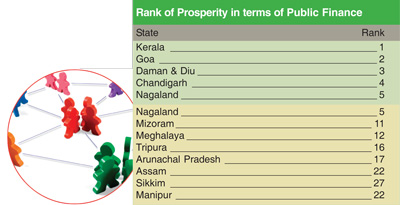
| Impact of globalization is unobservable or insignificant and privatization is at the back end for obvious reasons. Globalization and protection cannot go hand in hand. |
Overall infrastructural development is observed to be unsatisfactory in the entireNorth East. In spite of poor infrastructure the State of Tripura has done commendably well with respect to industrialization and Assam has gone ahead to encourage privatization. In other aspects of development such as banking, financial services, employment generation, tourism, human development and public efforts to facilitate and maintain developmental activities, there is a mixed finding among different States in the region. This is mainly due to rigidities, gaps, and imbalances in priorities and the efforts made to promote different aspects in coordination with each other. Success in achievement in better human development index in some States is mostly due to the contributions made by the missionaries and easy flow of funds from the Centre. Impact of globalization is unobservable or insignificant and privatization is at the back end for obvious reasons. Globalization and protection cannot go hand in hand. Private investment from within the region is not coming up and investment from outside is not encouraged due to protectionist attitude. Two important factors such as land and labor that are crucial to private investment are the major stumbling blocks in the region because of prevalent land laws and the so-called problems associated with migration of laborers from outside the region. How to resolve the contradiction between inner line permit systems, protection of indigenous cultures of the region, region’s political integration with the rest of the country and economic integration with the rest of Asia is a matter to ponder.


